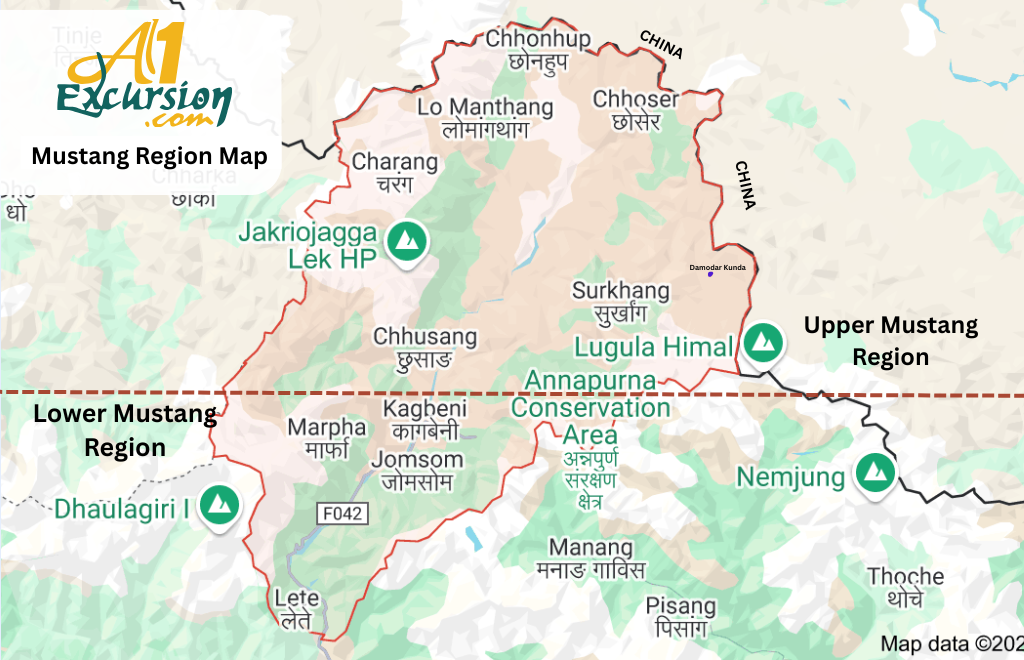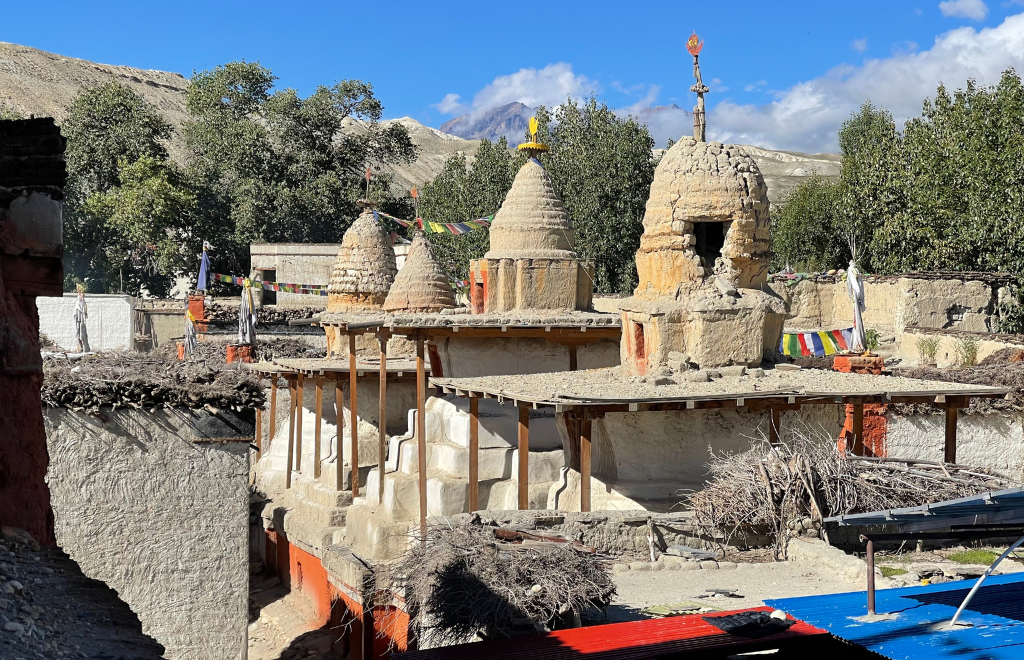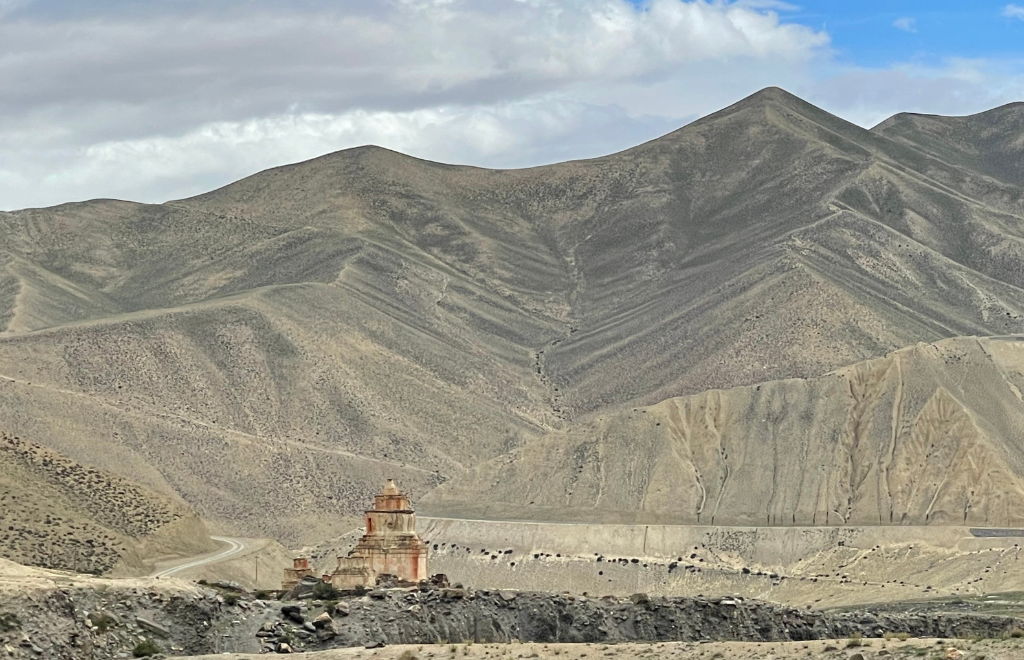Upper Mustang, once known as the Kingdom of Lo, is a remote region in the far northwest of the country, bordering Tibet. It covers the northern two-thirds of the Mustang District, Nepal lies in the rain shadow of the Annapurna and Dhaulagiri ranges, giving it a dry, desert-like landscape, unlike most parts of Nepal.
The region was closed to foreigners until 1992, earning it the title "The Last Forbidden Kingdom." Its isolation has helped preserve a unique Tibetan-Buddhist culture, centuries-old monasteries, cave dwellings, and traditional ways of life. The word “Mustang” means “Fertile Plain,” though its terrain is more rugged and barren than the name suggests.
Historically, Upper Mustang held strategic importance as a trade route between Tibet and India, especially for the ancient salt trade. Lo Manthang, the walled capital, was founded in the 14th century by Ame Pal and remains a center of heritage, spirituality, and Tibetan architecture.
Trekking through Upper Mustang Nepal, takes you through ancient monasteries, royal palaces, sky caves, and traditional villages that offer a rare look into a world untouched by time.
At A1 Excursion Adventure, we offer a range of precisely curated Upper Mustang tour and trekking packages designed to immerse you in the region’s unique culture and stunning landscapes.
To see the wonderful Upper Mustang landscape and culture, we have some popular packages:
Contact us today to start planning your unforgettable adventure to Nepal’s last hidden kingdom.

Where is Upper Mustang Nepal, located?
Upper Mustang lies in the northwestern region of Nepal, within the Mustang District of Gandaki Province. It is positioned beyond the Annapurna and Dhaulagiri ranges, in the Trans-Himalayan zone, and shares its northern border with the Tibetan Autonomous Region of China.
This unique geography places Upper Mustang in a high-altitude rain shadow, giving it a dry, desert-like terrain that’s distinct from the lush, green landscapes typical of other parts of Nepal. The region officially begins just north of Kagbeni, and its crown jewel is the ancient walled city of Lo Manthang, situated at an elevation of about 3,840 meters.
Cultural Significance of Upper Mustang Nepal: Heritage, Monasteries & Festivals
The cultural richness of Upper Mustang Nepal, is just as captivating as its landscapes. Tucked away in a remote corner of the Himalayas, this region serves as a living museum of Tibetan Buddhist traditions, preserved for centuries due to its geographic isolation and historical seclusion from outside influences.
Key Cultural Elements That Define Upper Mustang, Nepal
Ancient Monasteries and Gompas: Upper Mustang is home to sacred monasteries dating back over 600 years. Key sites include:
- Thubchen Gompa and Jampa Lhakhang in Lo Manthang
- Ghar Gompa, one of Nepal’s oldest Buddhist monasteries
- Choser Monastery & Sky Caves, used for meditation and burial rituals
Chortens & Mani Walls: Symbolic stone structures and prayer walls are found along trails and villages like Ghami and Dhakmar, showcasing spiritual devotion.
Living Tibetan Culture: The locals speak a Tibetan dialect and practice age-old customs, dress, and Buddhist rituals, unchanged for generations
Traditional Festivals:
- Tiji Festival (May): A vibrant three-day ritual dance festival held in Lo Manthang to dispel evil and bring prosperity
- Yarthung Festival (August): A thrilling celebration with horse races, archery, and communal gatherings
Due to its restricted access and limited exposure to modern tourism, Upper Mustang, Nepal, offers one of the purest cultural experiences in the Himalayas, where spirituality, art, and tradition are not only preserved but actively practiced.

Must-See Attractions in Upper Mustang, Nepal
If you’re traveling to this mystical region of Upper Mustang Nepal, here are the highlights you shouldn't miss:
- Lo Manthang, the former walled capital of the ancient Kingdom of Lo, features narrow alleys, royal residences, and revered monasteries like Chode Gompa, Jampa Monastery, and Thupchen Gompa, making it the spiritual and historical heart of Upper Mustang.
- Charang, the second-largest village in the region, is home to a crumbling royal palace, vibrant monastery, and traditional mud-brick homes surrounded by prayer walls and Chortens, highlighting its role in ancient trade routes.
- Ghami offers a quiet retreat with its traditional whitewashed houses, long mani walls, and red eroded cliffs, making it a cultural and visual gem on the Upper Mustang trekking trail.
- Chhoser enchants visitors with its ancient sky caves and Jong Cave, a mysterious five-story human-made structure. The nearby Kunchokling Cave Monastery adds spiritual allure to the area.
- Ghar Gompa (Lo Ghekar Monastery), believed to be founded by Guru Rinpoche, is one of Mustang’s oldest monasteries and offers panoramic views and spiritual richness.
- Kagbeni marks the entry point to Upper Mustang and retains its fortress-like charm. Located at the confluence of the Kali Gandaki and Jhong Rivers, it’s home to Kag Chode Monastery and steeped in Himalayan history.
- Marpha is famed for its apple orchards, cobblestone streets, and local products like apple brandy and cider. A cultural museum dedicated to Zen monk Ekai Kawaguchi adds historical depth.
- Jomsom, the administrative hub of Mustang, offers stunning views of Nilgiri and Dhaulagiri peaks. It serves as the main gateway for treks into Upper Mustang Nepal.
- Dhumba Lake, near Thini village, is a tranquil emerald-green lake sacred to Buddhists and fed by the pristine waters of Mt. Nilgiri.
- Lubra stands out as one of the last strongholds of the Bon religion, offering a unique insight into pre-Buddhist spiritual practices and traditional mountain life.
- Tangbe, Tetang, and Chuksang are ancient villages reflecting Mustang’s semi-arid culture, with whitewashed homes, apple orchards, bone relics, and hidden monasteries like Gompa Gang.
- Syanboche, at 3850 meters, provides sweeping Himalayan views. The sacred Chungsi Cave, where Guru Rinpoche meditated, adds a mystical dimension to the journey.
- Luri Gompa, dramatically perched on a cliff, is one of Mustang’s most iconic monasteries, known for its ancient wall paintings, cave architecture, and sacred Chortens.
- Yara and Ghara offer a rare glimpse into ancient matriarchal communities and timeless lifestyles, set amidst surreal cliffs, rock formations, and cave dwellings.
These must-see places in Upper Mustang, Nepal, encapsulate the region’s rich culture, spirituality, and raw natural beauty, making it a once-in-a-lifetime destination for explorers and culture seekers alike.
When to Visit Upper Mustang Nepal
Thanks to its location in the rain shadow of the Himalayas, Upper Mustang Nepal is one of the few trekking regions in the country that can be visited even during the monsoon season.
Best Time to Visit Upper Mustang Nepal:
- Spring (March–May): Experience mild weather, blossoming landscapes, and longer daylight hours—perfect for trekking.
- Autumn (September–November): Known for crisp skies, scenic clarity, and local festivals like Tiji and Yarthung that showcase rich Tibetan-Buddhist traditions.
Seasons to Avoid:
- Winter (December–February): Harsh cold and snowfall often result in closed tea houses and difficult travel conditions in higher altitudes.
Permits Needed to Visit Upper Mustang
Because Upper Mustang Nepal, is a restricted region, all travelers need special trekking permits:
- Restricted Area Permit (RAP): USD 500 per person for the first 10 days; USD 50/day thereafter.
- Annapurna Conservation Area Permit (ACAP): USD 30 per person.
- TIMS Card: Required for safety and tracking purposes.
Important: Solo trekking is not allowed. You must book your trip through a government-registered trekking agency and be accompanied by a licensed guide.
How to Reach Upper Mustang Nepal
Getting to Upper Mustang Nepal involves a mix of air and land transportation, followed by a trek or off-road journey.
Option 1: Flight + Drive/Trek
- Fly from Kathmandu to Pokhara (25 mins)
- Fly from Pokhara to Jomsom (20 mins) – A scenic flight offering mountain views
- From Jomsom: Drive by Jeep to Lo Manthang (approx. 2–3 days) via Kagbeni OR Begin your trek to Upper Mustang from Jomsom (7–10 days depending on the route)
Option 2: Drive from Pokhara
- Drive from Pokhara to Jomsom and then to Lo Manthang (Approx. 375 km)
- Road conditions are rugged; 4WD vehicles are strongly recommended
- The full drive can take 2 to 3 days, depending on weather and terrain
Whichever route you choose, the journey to Upper Mustang is just as memorable as the destination itself, filled with panoramic views, remote mountain villages, and ancient trails once used for salt trading with Tibet. To learn more, check out our detailed blog on how to reach Upper Mustang below.
- How to reach Upper Mustang

Final Thoughts: Why Upper Mustang Nepal, Should Be on Your Bucket List
Upper Mustang Nepal, is more than a destination; it’s a journey into a living museum of Tibetan culture, ancient Himalayan history, and raw natural beauty. From the walled city of Lo Manthang to sacred caves, lost monasteries, and windswept valleys, the region offers an experience unlike anywhere else in Nepal.
Whether you're exploring sky caves carved into cliffs, joining locals during the Tiji Festival, or walking through centuries-old monasteries still echoing with prayer, Upper Mustang invites you to step back in time and immerse yourself in something rare and unforgettable.
At A1 Excursion Adventure, we offer thoughtfully curated trekking and cultural tours to Upper Mustang Nepal, from classic hiking routes and overland jeep tours to special experiences during festival seasons.
Get in touch with us todayto start planning your once-in-a-lifetime journey to Nepal’s last hidden kingdom.
FAQs Frequently Asked Questions
1. Where is Upper Mustang Nepal located?
Upper Mustang is located in the northwestern part of Nepal, within the Mustang District of Gandaki Province. It lies beyond the Annapurna and Dhaulagiri ranges, near the Tibetan border, in a region known as the Trans-Himalayan zone.
2. Why is Upper Mustang called the “Last Forbidden Kingdom”?
Upper Mustang was closed to foreigners until 1992, preserving its Tibetan-influenced culture, ancient monasteries, and unique traditions. Its isolation led to the nickname "The Last Forbidden Kingdom."
3. What is the best time to visit Upper Mustang Nepal?
The best seasons to visit Upper Mustang are spring (March to May) and autumn (September to November). These months offer mild weather, clear skies, and cultural festivals like Tiji and Yarthung.
4. Do I need a permit to visit Upper Mustang?
Yes, Upper Mustang is a restricted region. You’ll need a Restricted Area Permit (RAP), an Annapurna Conservation Area Project (ACAP) permit, and a TIMS Card. Trekking must be done with a licensed guide via a registered agency.
5. Can I visit Upper Mustang without a guide?
No, solo trekking is not allowed in Upper Mustang. All travelers must be accompanied by a licensed guide and book their trip through a government-registered trekking agency.
6. How do I get to Upper Mustang Nepal?
You can reach Upper Mustang by flying from Kathmandu to Pokhara, then to Jomsom, followed by a jeep ride or trek to Lo Manthang. Alternatively, you can take an overland jeep route from Pokhara via Kagbeni.
7. What is Lo Manthang famous for?
Lo Manthang, the walled capital of Upper Mustang, is known for its ancient monasteries (Chode, Jampa, Thupchen), royal palace, and the annual Tiji Festival—a colorful Buddhist celebration.
8. What is the Tiji Festival in Upper Mustang?
The Tiji Festival is a three-day ritual held in Lo Manthang during May. It features traditional dances, costumes, and spiritual performances to drive away evil spirits and bring peace and prosperity.
9. How difficult is the Upper Mustang trek?
The Upper Mustang trek is considered moderate in difficulty. The trail involves some high-altitude walking (up to 3,900 meters), but the terrain is less steep compared to other Himalayan treks. Fitness and acclimatization are important.
10. Is Upper Mustang worth visiting?
Absolutely. Upper Mustang offers a rare blend of natural beauty, Tibetan Buddhist culture, ancient architecture, and unique geography. It's one of Nepal’s most culturally rich and visually striking regions—perfect for adventure seekers and culture lovers.






-1.webp)
-1.webp)
.webp)